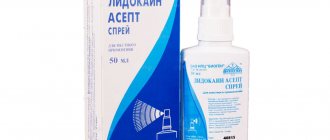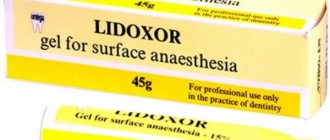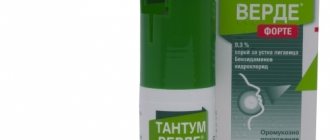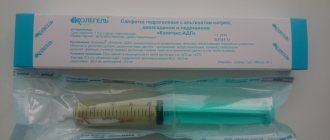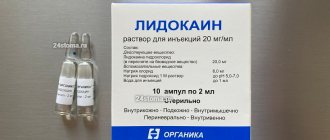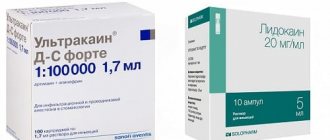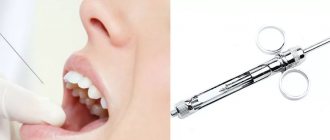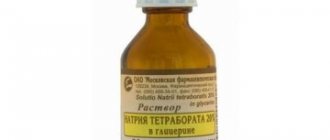Lidocaine spray for local use. dosed 4.6mg/dose 38g
Registration Certificate Holder
SYNTHESIS (Russia)
Dosage form
Medicine - Lidocaine-Akos
Description
Spray for local and external use
in the form of a transparent, colorless or yellowish liquid.
1 dose
lidocaine hydrochloride monohydrate 4.6 mg
Excipients
: ethanol 96% (rectified ethyl alcohol, “Extra” grade) - 18.4 mg, propylene glycol - 4.6 mg, sodium hydroxide - 0.23 mg, sodium saccharinate dihydrate (sodium saccharin) - 0.138 mg, racementol (racemic menthol) - 0.092 mg, water purified - up to 0.046 g.
340 doses - plastic bottles with a spray nozzle (1) - cardboard packs. 650 doses - plastic bottles with a spray nozzle (1) - cardboard packs.
Indications
For terminal (superficial) anesthesia of mucous membranes: in dentistry, in otorhinolaryngology, in obstetrics and gynecology, for instrumental and endoscopic examinations, in surgery and dermatology, radiographic examination (elimination of nausea and pharyngeal reflex).
Contraindications for use
Use for tonsillectomy and adenotomy in children under 8 years of age;
hypersensitivity to lidocaine. With caution
during instrumental studies (rectoscopy) in patients with hemorrhoidal bleeding, local infection in the area of application, trauma to the mucous membrane or skin in the area of application, severe somatic pathology, epilepsy, bradycardia, cardiac conduction disorders, impaired liver function, severe shock, young children, elderly patients, during pregnancy and lactation.
pharmachologic effect
Local anesthetic for superficial anesthesia. The action is due to the blockade of voltage-dependent sodium channels, which prevents the generation of impulses at the endings of sensory nerves and the conduction of pain impulses along nerve fibers.
When applied topically, it dilates blood vessels and does not have a local irritating effect. Has an analgesic effect.
The effect develops 1-5 minutes after application to mucous membranes or skin and lasts 30-60 minutes.
Drug interactions
Cimetidine and propranolol reduce the hepatic clearance of lidocaine (decreased metabolism due to inhibition of microsomal oxidation and decreased hepatic blood flow) and increase the risk of toxic effects (including stunned state, drowsiness, bradycardia, paresthesia).
Barbiturates, phenytoin, rifampicin (inducers of microsomal liver enzymes) reduce effectiveness (an increase in dose may be required).
When prescribed with ajmaline, phenytoin, verapamil, quinidine, amiodarone, the negative inotropic effect may be enhanced. Co-administration with beta-blockers increases the risk of bradycardia.
Curare-like drugs enhance muscle relaxation.
Procainamide increases the risk of developing central nervous system excitation and hallucinations.
With the simultaneous administration of lidocaine and hypnotics and sedatives, their inhibitory effect on the central nervous system may be enhanced.
With intravenous administration of hexobarbital or sodium thiopental against the background of the action of lidocaine, respiratory depression is possible.
Under the influence of MAO inhibitors, the local anesthetic effect of lidocaine may be enhanced.
With the simultaneous use of lidocaine and polymyxin B, an increased inhibitory effect on neuromuscular transmission is possible, so in this case it is necessary to monitor the patient's respiratory function.
Dosage regimen
Apply locally, externally. The dose depends on the indications and the area of the anesthetized surface.
Side effect
Local reactions:
a slight tingling sensation that disappears as the anesthetic effect develops (within 1 minute); Transient erythema, swelling and sensory disturbances may occur.
Allergic reactions:
very rarely - urticaria, angioedema, bronchospasm; in exceptional cases - anaphylactic shock. The use of the drug should be stopped immediately if any allergic reaction occurs.
After topical application, systemic effects rarely develop, because
Only a very small amount of the active substance can enter the bloodstream. From the side of the central nervous system:
very rarely - nervous excitement, systemic dizziness, insomnia, loss of consciousness and respiratory paralysis.
From the cardiovascular system:
decreased blood pressure, depression of myocardial function, bradycardia, cardiac arrest.
special instructions
Use with caution in patients with epilepsy, as well as bradycardia, cardiac conduction disturbances, impaired liver function and severe shock, especially when significant amounts of the drug can be expected to be absorbed when large areas of tissue are treated with high doses.
It is important to prevent lidocaine from entering the respiratory tract (risk of aspiration).
Application to the buccal mucosa is associated with a risk of dysphagia and subsequent aspiration, especially in children. If the sensitivity of the tongue and mucous membrane of the cheeks is impaired, the risk of biting them increases.
Lidocaine is well absorbed through mucous membranes (especially in the trachea) and damaged skin. This should be taken into account, especially when treating large areas of tissue in children.
In cases of use during surgical operations in the pharynx or nasopharynx, it should be taken into account that lidocaine, suppressing the pharyngeal reflex, enters the larynx and trachea and suppresses the cough reflex, which can lead to bronchopneumonia. This is especially important in children, as they are more likely to trigger their swallowing reflex. In this regard, the spray is not recommended for local anesthesia before tonsillectomy and adenotomy in children under 8 years of age.
Caution should be exercised when applying lidocaine to damaged mucous membranes and/or infected areas.
Lower doses should be used in weakened and elderly patients, in acute diseases, as well as in children - in accordance with age and general condition.
Effect on the ability to drive vehicles and machinery
During the treatment period, care must be taken when driving vehicles and engaging in other potentially hazardous activities that require increased concentration and speed of psychomotor reactions.
Use during pregnancy and breastfeeding
Restrictions during pregnancy - With caution. Restrictions when breastfeeding - With caution.
If local anesthesia is necessary and no safer treatment is available, lidocaine can be used during pregnancy.
Lidocaine is excreted in breast milk, but after topical use in normal therapeutic doses, the amount excreted in milk is too small to cause any harm to a nursing infant.
Use for renal impairment
Restrictions for impaired renal function - With caution.
In chronic renal failure, accumulation of metabolites is possible.
Use for liver dysfunction
Restrictions for liver dysfunction - With caution. The drug should be used with caution if liver function is impaired.
Use in elderly patients
Restrictions for elderly patients - Use with caution.
Use with caution in elderly patients.
Use in children
Restrictions for children - Use with caution. Use with caution in children. Use for local anesthesia before tonsillectomy and adenotomy in children under 8 years of age is not recommended.
Where is topical anesthesia used?
Most often it is used for pain relief when puncturing the skin during catheter insertion, injections, blood sampling, as well as in the following areas of medicine, such as:
- dentistry (for removing teeth and tartar, to relieve the gag reflex during procedures);
- surgery (for superficial surgical interventions. For example, when harvesting a flap for skin grafting, during mechanical cleaning of trophic ulcers);
- dermatology (for removal of molluscum contagiosum);
- cosmetology (before tattooing, hair removal, mesotherapy, laser therapy);
- gynecology (for removal of condylomas);
- pediatrics (for blood sampling, vaccinations).
Lidocaine spray for external and local use 10% 38g
Compound
Active substance: lidocaine hydrochloride monohydrate - 4.6 mg. Excipients: ethanol 96% (rectified ethyl alcohol, "Extra" grade) - 18.4 mg, propylene glycol - 4.6 mg, sodium hydroxide - 0.23 mg, sodium saccharinate dihydrate (sodium saccharin) - 0.138 mg, racementol (racemic menthol) - 0.092 mg , purified water - up to 0.046 g.
Pharmacokinetics
Rapidly absorbed from mucous membranes (especially the pharynx and respiratory tract).
The degree of absorption is determined by the degree of blood supply to the mucous membrane, the total dose, the localization of the site and the duration of application, the dosage form used. After application to the mucous membrane of the upper respiratory tract, it is partially swallowed and inactivated in the gastrointestinal tract. The time to reach Cmax when applied to the mucous membrane of the oral cavity and upper respiratory tract is 10-20 minutes. Protein binding depends on the concentration of the drug and is 60-80% at a drug concentration of 1-4 μg/ml (4.3-17.2 μmol/l). It is distributed quickly (T1/2 distribution phase - 6-9 minutes), first enters well-supplied tissues (heart, lungs, brain, liver, spleen), then into adipose and muscle tissue. Penetrates the BBB and placental barrier, secreted into breast milk (40% of the concentration in maternal plasma).
Metabolized in the liver (90-95%) with the participation of microsomal enzymes by dealkylation of the amino group and cleavage of the amide bond with the formation of metabolites that are less active compared to lidocaine (monoethylglycine xylidine and glycine xylidine), T1/2 of which is 2 hours and 10 hours, respectively.
Excreted with bile and kidneys (up to 10% unchanged).
In liver diseases, the metabolic rate decreases and ranges from 50% to 10% of the normal value.
In chronic renal failure, accumulation of metabolites is possible.
Indications for use
The drug can be used for local anesthesia in the following cases:
- in dentistry
- for terminal (superficial) anesthesia: anesthesia of the injection area before local anesthesia; opening of superficial abscesses; before suturing the mucous membrane; before fixing crowns and bridges; in the treatment of gum inflammation, periodontopathies; extirpation of baby teeth; removal of tartar;
- in otorhinolaryngology
- operations on the nasal septum and removal of nasal polyps; conducting electrocoagulation in the treatment of nosebleeds; elimination of the pharyngeal reflex and anesthesia at the injection site before removing the tonsils; opening of peritonsillar abscesses; puncture of the maxillary sinus;
- in obstetrics and gynecology
- egsiotomy and incision processing; removal of seams; minor operations on the vagina and cervix; rupture of the hymen; treatment of thread suppuration;
- for instrumental and endoscopic studies
- before inserting a probe through the nose or mouth (including duodenal intubation and fractional study of gastric secretion); during rectoscopy, intubation;
- during radiographic examination
- elimination of nausea and pharyngeal reflex;
- as an analgesic (pain reliever) drug
for burns (including sunburn); bites; contact dermatitis (including those caused by irritating plants); small wounds (including scratches);
- superficial anesthesia
of the skin during minor surgical interventions.
Contraindications
- hypersensitivity to lidocaine or any other component of the drug;
- use of lidocaine in the form of a spray for tonsillectomy and adenotomy in children under 8 years of age.
Carefully:
- instrumental studies (rectoscopy) in patients with hemorrhoidal bleeding;
- local infection in the area of application;
- trauma to the mucous membrane or skin in the area of application;
- severe somatic pathology;
- epilepsy;
- bradycardia, cardiac conduction disturbance;
- liver dysfunction;
- severe shock;
- concomitant acute diseases;
- weakened patients;
- pregnancy, breastfeeding period;
- younger children;
- elderly age.
Directions for use and doses
Apply locally, externally.
Dosage may vary depending on the indication and the size of the area to be anesthetized.
One dose of the spray, released by pressing the dosing valve, contains 4.6 mg of lidocaine.
Recommendations for the number of presses for various applications:
The drug can also be applied using a cotton swab soaked in it.
To avoid absorption of the drug into the systemic circulation, the minimum dose that ensures the effect should be used. Usually 1-3 clicks are enough; it is possible to use 15-20 or more presses (maximum dose - 40 presses per 70 kg of body weight).
In dental practice in children, it is preferable to use it as a lubricant (to avoid frightening the child when sprayed) by pre-impregnating a cotton swab.
Storage conditions
In a place protected from light, at a temperature not exceeding 25°C.
Keep out of the reach of children.
Best before date
3 years. Do not use after the expiration date stated on the packaging.
special instructions
When using, the bottle should be kept in an upright position.
Avoid contact with eyes and respiratory tract (risk of aspiration). Requires special care when applying the drug to the back of the throat.
Application to the buccal mucosa is associated with a risk of dysphagia and subsequent aspiration, especially in children.
If the sensitivity of the tongue and mucous membrane of the cheeks is impaired, the risk of biting increases.
Lidocaine is well absorbed through mucous membranes (especially in the trachea) and damaged skin. This should be taken into account, especially when treating large areas of tissue in children.
When using the spray during surgical operations in the pharynx or nasopharynx, it should be noted that lidocaine, suppressing the pharyngeal reflex, enters the larynx and trachea and suppresses the cough reflex, which can lead to bronchopneumonia. This is especially important in children, as they are more likely to trigger the pharyngeal reflex. In this regard, the spray is not recommended for local anesthesia before tonsillectomy and adenotomy in children under 8 years of age.
Caution should be exercised when applying lidocaine to damaged mucous membranes and/or infected areas.
The drug should be used with caution in patients with epilepsy, as well as bradycardia, cardiac conduction disorders, liver dysfunction and severe shock, especially when significant amounts of the drug can be expected to be absorbed when large areas of tissue are treated with high doses.
Lower doses should be used in weakened and elderly patients, in acute diseases, as well as in children - in accordance with age and general condition.
In children under 2 years of age, it is recommended to apply Lidocaine spray with a cotton swab dipped in the drug.
Description
Local anesthetic.
Dosage form
Spray for local and external use in the form of a clear, colorless or yellowish liquid.
Use in children
Contraindication: use of lidocaine in the form of a spray for tonsillectomy and adenotomy in children under 8 years of age.
Pharmacodynamics
Local anesthetic for superficial anesthesia.
The action is due to the blockade of voltage-dependent sodium channels, which prevents the generation of impulses at the endings of sensory nerves and the conduction of pain impulses along nerve fibers. When applied topically, it dilates blood vessels and does not have a local irritating effect. Has an analgesic effect.
The effect develops 1-5 minutes after application to mucous membranes or skin and lasts 30-60 minutes.
Side effects
At the site of application of the drug: a slight burning sensation that stops after the onset of anesthesia (within 1 minute), erythema, swelling, impaired sensitivity.
Allergic reactions: possible allergic contact dermatitis (hyperemia at the site of application, skin rash, urticaria, itching), angioedema, anaphylactic shock.
Use of the drug should be discontinued if any allergic reaction occurs.
The frequency of systemic reactions after the use of lidocaine aerosol is extremely low, because A very small amount of active drug is applied, which can enter the bloodstream.
In the case of large doses, as well as with rapid absorption, hypersensitivity, idiosyncrasy, and poor tolerability of the drug, the following side effects from the central nervous system and cardiovascular system may be observed.
Systemic reactions may be observed from the central nervous system: headache, dizziness, convulsions, tremor, blurred vision, tinnitus, agitation and/or depression, feelings of fear, euphoria, anxiety, fever, feeling of cold, respiratory depression.
From the cardiovascular system: increased blood pressure, decreased blood pressure, bradycardia, arrhythmia, depression of myocardial function.
Other: urethritis (after local application).
Use during pregnancy and breastfeeding
There are no results from controlled clinical studies in pregnant women.
If it is necessary to use local anesthesia and there is no safer treatment, the drug can be used during pregnancy.
Lidocaine is excreted into breast milk, but after normal therapeutic doses, the amount excreted in milk is too small to cause any harm to the nursing infant.
Interaction
- Vasoconstrictors (epinephrine, phenylephrine, methoxamine) prolong the local anesthetic effect of lidocaine.
- Cimetidine and propranolol reduce the hepatic clearance of lidocaine (decreased metabolism due to inhibition of microsomal oxidation and decreased hepatic blood flow) and increase the risk of toxic effects (including stunned state, drowsiness, bradycardia, paresthesia, etc.).
- Barbiturates, phenytoin, rifampicin (inducers of microsomal liver enzymes) reduce the effectiveness of lidocaine (an increase in dose may be required).
- When prescribed with ajmaline, phenytoin, verapamil, quinidine, amiodarone, the negative inotropic effect may be enhanced.
- Co-administration with beta-blockers increases the risk of bradycardia.
- Cardiac glycosides weaken the cardiotonic effect, curare-like drugs enhance muscle relaxation.
- Procainamide increases the risk of developing central nervous system excitation and hallucinations.
- With the simultaneous administration of lidocaine and hypnotics and sedatives, their inhibitory effect on the central nervous system may be enhanced.
- With intravenous administration of hexobarbital or sodium thiopental against the background of the action of lidocaine, respiratory depression is possible.
- Under the influence of monoamine oxidase inhibitors (furazolidone, procarbazine, selegiline), the local anesthetic effect of lidocaine may be enhanced. Patients taking monoamine oxidase inhibitors should not be given parenteral lidocaine.
- With the simultaneous use of lidocaine and nolimixin, an increased inhibitory effect on neuromuscular transmission is possible, so in this case it is necessary to monitor the patient’s respiratory function.
Overdose
Symptoms: increased sweating, pale skin, nausea, vomiting, dizziness, headache, blurred vision, ringing in the ears, diplopia, decreased blood pressure, bradycardia, arrhythmia, drowsiness, chills, numbness, tremor, anxiety, agitation, convulsions, methemoglobinemia, cardiac arrest.
Treatment: when the first signs of intoxication appear (dizziness, nausea, vomiting, euphoria), the patient is transferred to a horizontal position and oxygen inhalation is prescribed; for psychomotor agitation - 10 mg of diazepam intravenously; for convulsions - iv 1% solution of hexobarbital or sodium thiopental; for bradycardia - 0.5-1 mg of atropine intravenously, sympathomimetic agents (norepinephrine, phenylephrine). Dialysis is ineffective.
Impact on the ability to drive vehicles and operate machinery
During the treatment period, care must be taken when driving vehicles and engaging in other potentially hazardous activities that require increased concentration and speed of psychomotor reactions.
Lidocaine spray and EMLA: what is the difference?
The drugs differ in composition. If the spray contains only one substance - lidocaine, then EMLA cream contains lidocaine along with prilocaine.
Lidocaine and prilocaine belong to the class of amides of intermediate action. Their effect lasts on average 1-1.5 hours.
The anesthetic effect of lidocaine is 4 times higher than that of novocaine. It does not penetrate well through the surface epithelium of the skin. Therefore, the spray is more often used when performing manipulations on the mucous membranes - there the effectiveness of pain relief is higher.
Prilocaine is slower but longer acting than lidocaine and is less toxic. The combination of two anesthetics in EMLA cream allows you to prolong the effect of the drug and provide it with additional functions. For example, with ELMA the depth of pain relief depends on the duration of application, while with lidocaine spray the effect extends only to the superficial layers of the skin and then only when additional conditions are created (applying a patch or film that prevents moisture evaporation). Thus, the cream is suitable for both procedures performed on the skin and those performed on the mucous membranes.
